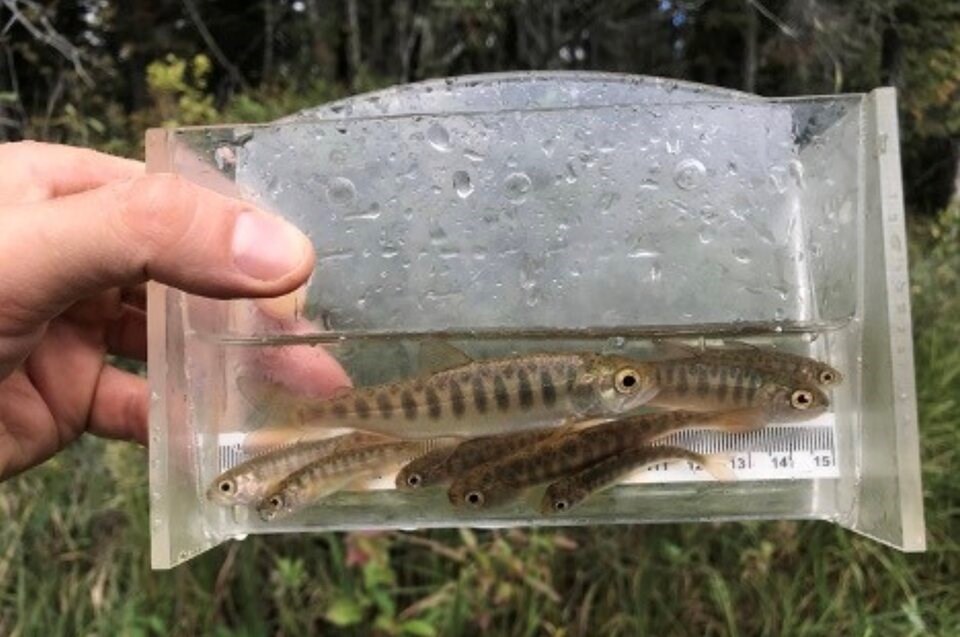Decades of logging has led to a “consistent and strong warming effect” in several salmon-bearing rivers across central British Columbia, adding another layer of heat stress to already struggling juvenile fish, a new study has found.
The research, published in the Canadian Journal of Fisheries and Aquatic Sciences last week, examined 28 tributaries of the North Thompson River between Kamloops and the Rocky Mountains. Along riverbanks where a third of trees had been logged over the past 50 years, average temperatures were found to spike beyond 17 degrees Celsius — enough to stress juvenile coho salmon before they get a chance to migrate toward the sea.
“What this really means is that at higher temperatures these fish need to work harder and eat more to keep their weight up,” said Dylan Cunningham, lead author and a researcher at Simon Fraser University (SFU).
“The problem is, there isn’t always going to be extra food available.”
Juvenile coho thrive in rivers with water temperatures between 12 and 15 C in the summer. As water warms, it holds less oxygen. Anything higher than 17 C can stress juvenile coho.
Fish struggle to breathe and their metabolism speeds up, forcing them to burn more energy faster. One study found once temperatures climb past 20.3 C, salmon stop growing because they can't get enough food to satisfy their metabolism.
“High temperatures, especially when they last over long periods of time, can reduce growth rates, migration and spawning success, and even kill fish,” Cunningham said.
Warmer streams also mean that fewer adult salmon are reaching spawning ground to give rise to the next generation. And those that do make it leave young fish more vulnerable to disease and predators, Cunningham said.
None of the 28 streams Cunningham and his colleagues studied hit summertime highs warmer than 25.9 C, the point where warming water can become lethal. But in four rivers, temperatures climbed past 20.3 C, the threshold where some have found juvenile coho stop growing.
In some watersheds, deforestation rates climbed to 59 per cent.
“I was surprised by the large extent of logging that occurred in some of these headwater stream networks,” said Cunningham, who carried out the study at SFU’s Salmon Watershed Lab in collaboration with researchers at Fisheries and Oceans Canada.
But Cunningham cautioned against painting a direct line between logging and high temperatures in nearby rivers. That's because deforestation along a river's edge isn't the only thing that will determine how hot its waters will be. Elevation, the presence of groundwater and glacier runoff and its underlying geology can all influence a river's temperature.
Still, added Cunningham, on average, the more intensive logging near a river, the higher stream temperatures appear to be.
Hot water hitting an already threatened fish
Spawning coho salmon populations on the North Thompson River have already dropped 60 per cent since the 1990s, largely a result of historic over-fishing, changing ocean conditions, and damage to freshwater habitat, past studies have found.
Now, the SFU scientists concluded, logging and climate change are pushing an already threatened fish population even closer to disaster. Streams home to Pacific salmon are warming up and down the West Coast, including in the Fraser River, wrote the scientists. A further decline in salmon could have an even more devastating impact on First Nations and animals that rely on fish as a source of food.
As Cunningham put it: “The health of our streams is deeply connected to the health of our forests.”
More than 90 per cent of the logging the scientists measured was near smaller streams higher up the watershed — places where current logging regulations don't require companies to leave a barrier of trees along these rivers.
Their research suggests a critical choice in a warming world: cut more riverine forests and boost temperatures in already warming waters, or leave salmon's best shady buffer in place.





